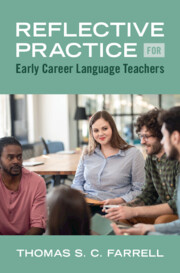Refine search
Actions for selected content:
54 results
Talking about the taboo: how perceptions regarding women’s health inform cognitive behavioural therapists’ practice with women experiencing chronic pelvic pain
-
- Journal:
- The Cognitive Behaviour Therapist / Volume 18 / 2025
- Published online by Cambridge University Press:
- 21 November 2025, e58
-
- Article
-
- You have access
- Open access
- HTML
- Export citation
Looking within: exploring the effects of social identity-based reflection on novice designers’ task clarification behavior
-
- Journal:
- Design Science / Volume 11 / 2025
- Published online by Cambridge University Press:
- 19 June 2025, e18
-
- Article
-
- You have access
- Open access
- HTML
- Export citation
Chapter 21 - Taking a Lifestyle History
- from Section 4 - Clinical Skills in Lifestyle Medicine
-
-
- Book:
- Essential Lifestyle Medicine
- Published online:
- 01 May 2025
- Print publication:
- 15 May 2025, pp 229-241
-
- Chapter
- Export citation

Professional Supervision for Principals
- A Primer for Emerging Practice
-
- Published online:
- 07 January 2025
- Print publication:
- 20 March 2025
-
- Element
- Export citation

Reflective Practice for Early Career Language Teachers
-
- Published online:
- 30 November 2024
- Print publication:
- 28 November 2024
Chapter 2 - Getting the Story
-
- Book:
- Reflective Practice for Early Career Language Teachers
- Published online:
- 30 November 2024
- Print publication:
- 28 November 2024, pp 15-25
-
- Chapter
- Export citation
4 - Reflective Practice and Teacher-Led Research
-
- Book:
- Professionalising English Language Teaching
- Published online:
- 24 October 2024
- Print publication:
- 21 November 2024, pp 72-98
-
- Chapter
- Export citation
Chapter 17 - Science education: professional learning through reflective practice
- from Part 4 - How do I plan and assess in science?
-
-
- Book:
- Science in Early Childhood
- Published online:
- 13 December 2023
- Print publication:
- 10 January 2024, pp 264-277
-
- Chapter
- Export citation
2 - An Understanding
-
- Book:
- Understanding the Role of Equity
- Published online:
- 12 October 2023
- Print publication:
- 26 October 2023, pp 18-45
-
- Chapter
- Export citation

Understanding the Role of Equity
- Equity Focused Case Studies for Education Leaders
-
- Published online:
- 12 October 2023
- Print publication:
- 26 October 2023

Cambridge Guide to Psychodynamic Psychotherapy
-
- Published online:
- 25 August 2023
- Print publication:
- 10 August 2023
Chapter 15 - Applications of Psychodynamic Theory and Principles outside of Specialist Psychotherapy Settings
- from Beyond 1:1 Therapy: Working Psychodynamically with Clinicians, Teams, and Organisations
-
- Book:
- Cambridge Guide to Psychodynamic Psychotherapy
- Published online:
- 25 August 2023
- Print publication:
- 10 August 2023, pp 231-243
-
- Chapter
- Export citation
Chapter 20 - A Psychodynamic Approach to Working with People Experiencing Multiple Exclusion Homelessness
- from Other Forms and Settings of Psychotherapeutic Work
-
- Book:
- Cambridge Guide to Psychodynamic Psychotherapy
- Published online:
- 25 August 2023
- Print publication:
- 10 August 2023, pp 291-299
-
- Chapter
- Export citation
Chapter 16 - An Introduction to the Dynamics of Anger, Aggression, and Violence
- from Beyond 1:1 Therapy: Working Psychodynamically with Clinicians, Teams, and Organisations
-
- Book:
- Cambridge Guide to Psychodynamic Psychotherapy
- Published online:
- 25 August 2023
- Print publication:
- 10 August 2023, pp 244-257
-
- Chapter
- Export citation
Chapter 17 - Psychologically Informed Organisations and Services
- from Beyond 1:1 Therapy: Working Psychodynamically with Clinicians, Teams, and Organisations
-
- Book:
- Cambridge Guide to Psychodynamic Psychotherapy
- Published online:
- 25 August 2023
- Print publication:
- 10 August 2023, pp 258-268
-
- Chapter
- Export citation
Chapter 18 - Psychodynamic Reflective Practice Groups
- from Beyond 1:1 Therapy: Working Psychodynamically with Clinicians, Teams, and Organisations
-
- Book:
- Cambridge Guide to Psychodynamic Psychotherapy
- Published online:
- 25 August 2023
- Print publication:
- 10 August 2023, pp 269-277
-
- Chapter
- Export citation
7 - Exploring the Quintain
-
- Book:
- Teacher Expertise in the Global South
- Published online:
- 18 May 2023
- Print publication:
- 01 June 2023, pp 119-162
-
- Chapter
- Export citation
Foregrounding the ageing self: a duoethnographic account of growing older as a gerontologist and educator
-
- Journal:
- Ageing & Society / Volume 44 / Issue 11 / November 2024
- Published online by Cambridge University Press:
- 27 February 2023, pp. 2444-2463
- Print publication:
- November 2024
-
- Article
- Export citation
Chapter 7 - Reflective practice in partnership work
-
- Book:
- Partnerships with Families and Communities
- Published online:
- 21 February 2023
- Print publication:
- 17 February 2023, pp 120-136
-
- Chapter
- Export citation
Chapter 6 - Strategies and challenges for implementing partnerships
-
- Book:
- Partnerships with Families and Communities
- Published online:
- 21 February 2023
- Print publication:
- 17 February 2023, pp 106-119
-
- Chapter
- Export citation
